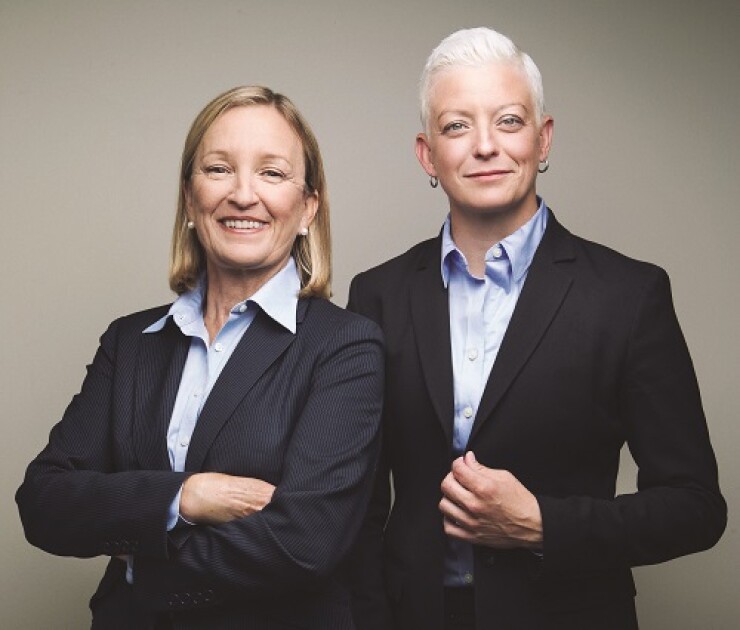
In searching for a junior partner for her practice a few years ago, advisor Donna Drosner went through several candidates, but none were the right fit.
But then, at a women’s business dinner in December 2012, Drosner asked her neighbor at the table, Emily Phillips, a millennial working at a consulting firm, what she did for a living. “I told [Drosner] I essentially sit down with large companies and figure out what their pain points are and how we can find solutions,” Phillips recalls.
“I asked her what she does, and she said she was an advisor at Baird. And I thought, ‘God, how boring,’” Phillips says, laughing. “But she explained how she worked with people to build their dreams.”
After they got to know one another over further meetings, Phillips decided to sign up as Drosner’s junior partner. Looking back, Drosner says she found a good fit for her practice. “In financial services, there are a lot of highly educated, intelligent people,” she says. “That’s a given because to enter the industry you have to be smart. But what I found in Emily was someone who could truly listen — who would listen to the clients.”
Finding the right junior partner is a challenge that many advisors continue to face. There are thousands of producers in the business who remain solo acts, either because they prefer it or have yet to find the right partner.
“This is somebody that you are going to spend the rest of your career with,” says RBC advisor Darla Kashian. “You might spend more time with that person than your spouse. It has to be a good fit.”
For solo advisors, especially those thinking of retiring, pairing up with a junior advisor offers tantalizing benefits for both sides, industry insiders say: a clear succession plan for senior advisors and their clients, a re-energized practice, and an easier on-ramp into the profession for junior advisors.
Here’s what experts and advisors say you can do to land the right partner, someone who’s a good fit for you and the clients.
MATCHMAKERS
Take advantage of matchmakers. In an industry where the advisor ranks are graying, it can be hard to find a junior partner, let alone a good match. In the words of one solo advisor: There are a lot more brides than grooms.
Firms have tried to address this problem through various matchmaking efforts.
Wells Fargo, for example, has an 18-month-old program to pair up trainees with senior advisors. More than 180 new advisors have joined the program.
Similarly, Merrill Lynch started an alternative training program last year called Team Financial Advisor. These trainees go through a 36-month curriculum while working directly on a team.
Yet despite firms’ efforts, a lot of matchmaking continues to happen at the local level. Some advisors bring outsiders into the industry, as Drosner did with Phillips.
Other advisors have brought in sons, daughters and other relatives.
And some advisors find prospective partners in their own branches. “You really have to get to know someone,” says Brian Lampsa, a Chicago branch manager at Raymond James & Associates. “That’s why working with someone in your existing office is such a huge advantage. You’ve watched them develop and interact with clients.”
VETTING
Knowing where to search is only the first step, insiders say. Equally important, if not more so, is fit. In fact, fit is a word that comes up often when talking with advisors and experts about partnerships.
“When someone has been in this business for a long time, their friends become their clients and their clients become their friends,” Lampsa says. “So the idea of finding a successor is as much about the monetary side of it as it is about the comfort that your clients will be taken care of. That is why fit is so critical.”
In 2010, Darla Kashian became a junior partner to Dorothy Marden, an advisor, now retired, who saw Kashian in action at their RBC branch in Minneapolis.
Kashian notes that they were different in some ways (Marden was a CPA while Kashian had studied English and theology in college, for example). But they had fundamental things in common.
“I think why it worked is we shared very similar values,” Kashian says. “She trusted me and I trusted her.”
When the two paired up, Kashian spent 20 to 25 hours a week learning the ins and outs of Marden’s practice and clients. “That was the No. 1 ticket to success,” she says. “I really got to know how Dorothy saw it and how we got to where we were with these clients. I don’t think you can get to that any other way without being there firsthand.”
In vetting junior candidates, Raymond James advisors Bob Hilton, 62, and Joe Blanton, 71, not only did multiple interviews per candidate, they even took them out to dinner with their spouses. “Joe’s wife and my wife have good people skills,” Hilton says. “They might see something we don’t.”
They eventually chose an advisor about 30 years their junior, Rachel McNeil. Hilton says she has been a great addition to the team.
Their extensive four-month interview process was a must, Hilton says, adding that he would have done interviews for an entire year rather than settling for someone and being afraid that he would ultimately have to tell his clients that the junior partner he had hired was leaving.
“The last thing you need is a negative,” says Hilton, who is based in St. Petersburg, Fla. “You get a negative into the team and it brings everything down.”
He adds: “You only get these opportunities every so often and a mistake is painful. In our business, a divorce is probably more painful than a marital divorce, at least financially.”
PAYTIME
Advisors teaming up also need to understand what they’re getting into and how they’ll be paid.
Talking about money up front can avoid headaches, as each advisor needs to feel he or she is being equitably paid, insiders say.
Steve Drake, 58, oversees $850 million in client assets at RBC. When he brought on two sons-in-law as advisors new to the business, he offered them a deal: fulfill certain responsibilities and get a generous salary for the first five years, after which you can renegotiate for a stake in the business if you want.
This is a smoother way to bring new people onboard than the traditional path for new advisors, Drake says.
“These guys have degrees in finance,” Drake says. “One already has the CFP; one is working on it. They’ve both taken Dale Carnegie. They both sit in on literally 150 meetings a year with people worth over $1 million, and then work on the financial plans.”
Kashian says that her RBC complex director was very involved in helping her and Marden set up the financial aspect of their partnership.
“It’s not about getting to a perfect agreement,” Kashian says. “But the process can be so difficult that if people don’t feel like it’s a fair arrangement, then it can be a disaster.”
Getting these arrangements done can also go a long way to building team spirit. Raymond James advisor Eric Seidl, 39, says that when he became a partner of Don Ballarini, an advisor who is now retired, the two worked out a pay scale so that if they met certain goals, Seidl would get a larger percentage of the business. They also agreed on sharing new clients equally.
“I think it was important because we knew what our expectations were,” Seidl says. “I think that, particularly as a younger advisor, if you can see the light at the end of the tunnel, that you will put in hard work into this partnership and get rewarded.”
ROLE DEFINITION
Is someone responsible for the financial plans? Is there a designated rainmaker? Identifying each partner’s roles and responsibilities will help find who is a good fit for the practice, and it’ll give the partnership a firmer foundation, industry insiders say.
“In this partnership, I’m the old guy with gray hair; I need to be raising money,” Drake says. His partners are “really good at keeping up with clients and servicing. There are a million people searching for the [junior] advisor that will serve up clients and prospects. But that’s our hardest skill set.”
In Drosner’s case, she was looking for someone with the same qualities she had when she started out as an advisor.
“It’s a rare quality to be able to go out and gather assets,” she says. “You can leverage connections and networks, but a true hunter is not easy to find. Emily has those qualities, which made her the perfect fit.”
REALISTIC EXPECTATIONS
Senior advisors also say it’s important to have reasonable expectations from your partner, particularly if the junior one is brand new to the profession. “You can’t hire a rainmaker who doesn’t have a personality,” Hilton says.
Phillips says that Drosner was upfront about the challenges she would face in getting up to speed on the business.
“She told me that it will take you a year to rebrand, to change how you communicate, to change how you think,” Phillips says. “It will take time for you to build that up and build up credibility so that when people hear Emily Phillips, they say, ‘Oh, she works at Baird.’ That gave me perspective on how to add to the practice that already existed.”
Branch managers sometimes help advisors define partner’s obligations, and some firms provide support structure too. Matt Sebenoler, vice president of next generation advisor strategies at Wells Fargo, says his firm’s program to pair senior and junior advisors isn’t limited to training and tips.
“We have a role and responsibility document that they have to sign in advance,” Sebenoler says. “No one can say that they didn’t know what they were supposed to do.”
Insiders say that while the specifics may vary case by case, getting everyone on the same page ensures that partners are working toward common goals and not at cross purposes.
And it keeps them invested in the partnership. “I think that when folks leave or opt out, from the junior advisor side, they don’t see how they are going to get there. They don’t see me retiring or see themselves becoming true partners,” says Matt Ransom, vice president of new advisor development at Raymond James.
TEAM SPIRIT
True partnerships aren’t built in a day, insiders say, and partners should be prepared for a period of acclimating to each other. Senior advisors say they have worked hard to help their junior partners get acclimated, especially those entirely new to the industry.
“That first year, you don’t think there can be that many questions, but there are,” Drosner says. “But if you do that, and patiently, it really goes a long way to speeding up the assimilation process.” Having open lines of communication is critical, according to both junior and senior advisors. “If you have a concern, it should be addressed,” Drosner says.
Experts agree. “These relationships are like marriages and communication is a key part of the foundation,” Ransom says.
Finally, the senior advisor must be willing to fully integrate the junior advisor into the practice. You can’t just hand them the clients you don’t like, advisors and experts say.
“The senior advisor has to be confident enough to let someone else talk to their clients,” says Lampsa of Raymond James. “The hardest part of building a team in this business is to have the lead person let go and let the team handle some things. It has to go from ‘my clients, my business’ to ‘our clients, our business.’”
ME VERSUS WE
Advisors recognize that partnerships are a great idea, but when the reality sets in, too many ask, What’s in it for me? Drosner says.
It’s an attitude that doesn’t result in success, she notes.
“When you go into a partnership, the most effective way to do it is to look at it as something that will produce something that is bigger than one individual,” Drosner says.
Two years into their partnership, Drosner and Phillips say that they are happy. But when talking with other advisors, Drosner remains cognizant that getting here wasn’t easy.
“For all of the talk about how important it is to have a partnership, the reality is that it is difficult to form a successful partnership,” she says. “No one does statistics on the ones that don’t work.”
As for the partnerships that do work well, a lot of effort goes into establishing them, from searching for a partner, creating an equitable pay structure and setting the right expectations. And those efforts build confidence between the partners and in the partnership. Advisors say this has been a critical ingredient in the success of their partnerships. It’s what makes a fit feel right.
Read more:






